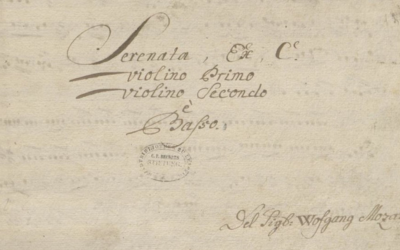Mozart: A Manufactured Miracle
The Questionable Legacy of Niemetschek’s Biography
Franz Xaver Niemetschek’s 1798 Life of the Royal and Imperial Kapellmeister Wolfgang Gottlieb Mozart has been considered the first authentic biography of Mozart. But was it? The Bohemian author’s motivations were far from objective.
His relationship with Mozart’s widow, Constanze, and his ties to the Leipzig publisher Breitkopf & Härtel reveal a hidden agenda. Rather than offering a balanced portrait of Mozart’s life, Niemetschek fashioned an image of a flawless genius to sell Mozart’s works as patriotic relics of the Habsburg Empire.
His narrative has fueled the Mozart myth for over two centuries, paving the way for the profitable “Mozart Inc.” we know today.
Mozart: The Fall of the Gods
This book compiles the results of our studies on 18th-century music and Mozart, who has been revered for over two centuries as a deity. We dismantle the baseless cult of Mozart and strip away the clichés that falsely present him as a natural genius, revealing the contradictions in conventional biographies. In this work, divided into two parts, we identify and critically analyze several contradictory points in the vast Mozart bibliography. Each of the nearly 2,000 citations is meticulously sourced, allowing readers to verify the findings. This critical biography of Mozart emerges from these premises, addressing the numerous doubts raised by researchers.
"The emperor’s clothes are only as resplendent as we choose to believe."
Mozart: The Fall of the Gods
The Illusion of Greatness: Niemetschek’s “Sources”
Franz Xaver Niemetschek, the Bohemian writer and purported biographer of Wolfgang Mozart, holds a peculiar place in history. His 1798 Life of the Royal and Imperial Kapellmeister Wolfgang Gottlieb Mozart has often been hailed as an “authentic” account of the composer. But Niemetschek’s agenda was clear: his work was never intended as an impartial study of Mozart’s life or his compositions. Instead, it functioned as a marketing tool for an emerging Mozart industry that continues to reap profits from the mythical genius it helped construct.
Niemetschek claimed familiarity with Mozart through a fleeting interaction in 1791, yet his biography relies heavily on secondhand stories, many directly from Constanze Mozart. The narrative he constructs is one of a preordained musical hero—a notion crafted more for public consumption than historical accuracy. The portrayal of Mozart as a “natural genius” was convenient for the Leipziger publisher Breitkopf & Härtel, whose Allgemeine musikalische Zeitung (first published in 1798) aimed to boost the sales of Mozart’s works, particularly the Requiem, in what became one of the most lucrative musical ventures of the time.
An “Objective” Biographer, or Constanze’s Confidant?
It’s important to question just how “authentic” Niemetschek’s biography is, considering his close ties to Mozart’s widow, Constanze. Following Mozart’s death, Niemetschek even became a guardian for Mozart’s son Carl Thomas, taking him into his household in Prague. The composer’s legacy, still fresh and vulnerable, was shaped under Niemetschek’s pen, blending anecdotes and glorifying Mozart to foster his image as a patriotic figure of the Habsburg Empire.
Yet, as a writer with direct access to Constanze, Niemetschek had little motivation to critique or provide a balanced assessment of Mozart’s achievements. Instead, he echoed her selective recollections, presenting an image that satisfied the sentimental and patriotic cravings of a Europe that, having subdued the Napoleonic threat, was primed to embrace Mozart as a quasi-national treasure. One wonders how many of these “authentic” sources were curated to portray Mozart as a musical saint, a narrative neatly suited to boosting sales of his works.
Heroism and Hysteria: The Myth of the ‘Divine Genius’
Niemetschek’s biography didn’t simply recount Mozart’s life; it transformed him into a miraculous phenomenon. In his narrative, Mozart was a prodigy whose work emerged fully formed from an otherworldly spark, devoid of human struggle or imperfection. This portrayal is wildly at odds with the letters and historical accounts showing Mozart’s creative process, which often involved a keyboard as an aid for composition. Furthermore, the biography’s pages overflow with florid, heroic language, casting Mozart as a towering, tireless creator—contrary to Leopold Mozart’s frequent chastisement of his son for his disorganization and perceived laziness.
This romanticized narrative has permeated Mozart’s legacy, divorcing him from the realities of his complex, mutable style and from the frustrations he faced. By insisting on an idealized, infallible image, Niemetschek laid the groundwork for what is now a deeply entrenched Mozart mythology—a myth that has blurred our understanding of his real artistic journey. The result was an image so polished, so unreal, that even today it fuels the immense profits of the “Mozart industry.”
Mozart Inc.: The Birth of a Brand
It would be naïve to consider Niemetschek’s biography as merely a labor of admiration. His collaboration with Breitkopf & Härtel ensured a steady stream of Mozart compositions to Leipzig, transforming the composer’s name into a lucrative enterprise. This early “branding” of Mozart—by presenting him as a perfect, timeless genius—allowed for greater commodification, turning his works into assets that transcended mere musical appreciation.
The Mozart myth has since ballooned into a multinational enterprise. Today, “Mozart Inc.” ranks among the top cultural brands worldwide, drawing on the same fabricated stories and hyperbolic anecdotes that Niemetschek pioneered. Far from a historically grounded portrayal, Niemetschek’s Mozart has morphed into a symbol of perfection, whose story is recycled endlessly to sustain an industry based on illusion.
A Legacy of Misinformation
In closing, Niemetschek’s so-called biography is little more than an advertising campaign dressed up as a historical account. Its credibility, propped up by early 19th-century publishers and Mozart’s family, remains largely unchallenged by mainstream musicology, which curiously still references Niemetschek’s work as a reliable source. The enduring grip of this narrative reveals a deep-seated cultural bias, a reluctance to separate fact from fantasy when it comes to cherished icons.
As long as the commercial machinery continues to churn, it seems the Mozart myth will remain untouchable—a testament to the power of narrative over truth. Today, more than ever, we must ask ourselves whether we are content to celebrate an idealized Mozart or if we are ready to scrutinize the legend with the critical eye it deserves. After all, “the emperor’s clothes are only as resplendent as we choose to believe.”
You May Also Like
Mozart’s Serenade? A New Discovery? Really?
In Leipzig, what was thought to be a new autograph of Mozart turned out to be a questionable copy. Why are such rushed attributions so common for Mozart, and why is it so hard to correct them when proven false?
Mozart’s K 71: A Fragment Shrouded in Doubt and Uncertainty
Mozart’s K 71, an incomplete aria, is yet another example of musical ambiguity. The fragment’s authorship, dating, and even its very existence as a genuine Mozart work remain open to question. With no definitive evidence, how can this fragment be so confidently attributed to him?
Unpacking Mozart’s Early Education
The story of Ligniville illustrates the pitfalls of romanticizing Mozart’s early life and education, reminding us that the narrative of genius is often a construct that obscures the laborious aspects of musical development.
The False Sonnet of Corilla Olimpica
Leopold Mozart’s relentless pursuit of fame for his son Wolfgang led to questionable tactics, including fabricating a sonnet by the renowned poetess Corilla Olimpica. This desperate attempt to elevate Wolfgang’s reputation casts a shadow over the Mozart legacy.
Mozart’s K 73A: A Mystery Wrapped in Ambiguity
K.143 is a prime example of how Mozart scholarship has turned uncertainty into myth. With no definitive evidence of authorship, date, or purpose, this uninspired recitative and aria in G major likely originated elsewhere. Is it time to admit this is not Mozart’s work at all?
A Farce of Honour in Mozart’s Time
By the time Wolfgang Amadeus Mozart received the Speron d’Oro, the once esteemed honour had become a laughable trinket, awarded through networking and influence rather than merit. Far from reflecting his musical genius, the title, shared with figures like Casanova, symbolised ridicule rather than respect.







